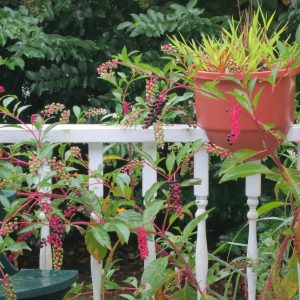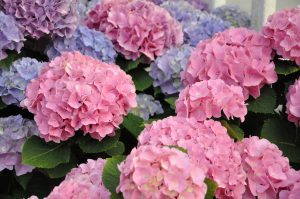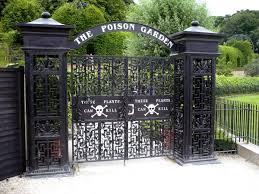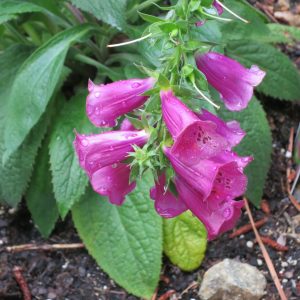If there are no paragraph separations in this article, please double-click on the title to create a more readable version.

Our Carolina cousins have an enthusiastic love of gardening, so hauling dirt and digging holes for their plants is part of our semi-annual visits. As an extra bonus, Sheila enjoys learning about the Southern flower and tree varieties that our chilly Northern weather prevents us from growing.
This last visit was busier than usual after I noticed quite a few poisonous plants that cuz had added to the garden areas. I mentioned my discoveries about foxglove and a few other attractive specimens and we came up with a landscaping design that would feature their own choices in a special section, nestled up against the deadly oleander. We got busy and transplanted the varieties, gloved up and wearing long sleeves and pants while doing the work.
Here’s a list of the ones we placed in the poison grouping, along with the effects of the plants on humans when not handled properly. There is a mixture of sun and shade during the day in this area, so many of these plants are shade loving or at least shade tolerant under all the pines and in the intense summer heat.
Azalea – all parts of the bush are toxic and can cause progressive paralysis
Bleeding Heart – leaves and roots toxic in large quantities
Chrysanthemums – leaves and flowers can cause blisters, diarrhea, nausea, lack of coordination
Foxglove – all parts toxic, but berries especially poisonous and can kill
Geraniums – handling the plants can cause irritation
Holly trees – eating the berries can cause death in children
Hydrangea – leaves and flowers can cause convulsions and coma if ingested
Iris – underground stems cause severe digestive upset
Lantana – unripened berries can cause difficulty breathing or death if ingested
Lily of the Valley – can cause death in children if any part is eaten
Oleander – all parts are toxic and can kill
Peonies – eating flowers and seeds can cause tremors, severe diarrhea, and vomiting
Pokeweed – all parts of the plant are toxic, and it gets deadlier as it gets bigger and older

Why have all these poisonous plants? With the variety of colors, leaf textures, and overlapping blooming schedules, that area of the yard is a constant source of enjoyment for people and the bees. The cousins don’t have pets or young children, so there are no safety concerns, other than always wearing gloves (and sometimes long sleeves) when caring for the garden.
Some toxicity information is from www.thespruce.com
One of the most famous poison gardens in the world can be found in the Alnwick Castle Gardens in Northumberland, England. In the late 1990s, the Duchess was tasked with improving the neglected landscaping. Rather than repeating the layout found in other famous gardens, she created a poison garden, where every one of the 100 toxic plants has the ability to kill you. The reason for her decision? She thought it would be much more interesting on the tours to chat about what was deadly, rather than what was merely pretty.
Finished in 2005, many are considered cottage garden plants, since they are found in ordinary gardens around the country. Most people just are not aware of how deadly the plants can be, but the workers wear gloves and sometimes full Tyvek suits while working with the specimens. Below is a partial list of the lethal flowers and shrubs in the Alnwick Poison Garden.

- Aconitum
- Brugmansia (a type of trumpet vine)
- Castor Bean plant
- Foxglove
- Belladonna – deadly nightshade
- Hellebores
- Hemlock
- Laburnum
- Laurel hedge (leaves in a jar kill insects dropped in, but leave them otherwise undamaged)
- Lily of the Valley
- Oleander
- Poppies
- Pokeweed
- Rhododendron
- Vinca major

One representative is a plant that both helps and kills. Castor Oil is made from the plant (Castor Bean Plant) Ricinus communis, but a single seed from the same plant will kill an adult in the most horrible way. Ricin causes nausea, severe vomiting, convulsions and subsequent disintegration of the kidneys, liver and spleen.
The Blarney Castle Poison Garden, in County Cork, Ireland, has been nestled against the battlements since the 1400s. Laid out beautifully, it is updated periodically and the head gardener is planning an expansion with a display of carnivorous plants. Open to the public, there are warnings everywhere not to touch the plants.
The Medici Poison Garden, in Padua, Italy, is part of the oldest botanical garden in a university setting in the world. It dates from 1545 and was established because the Medici family developed poisons from plants so that they could dispatch their enemies. These days, the site has a more medicinal/research theme.
Poison or medicine? Sometimes, the difference is in the dosage.
But, no matter what, be careful in your garden. There are many more plants that could be dangerous to your health. Ask questions at the garden center if you have pets or small children at your house, but still want to have a great garden.
*Flower photos taken in North Carolina by Patti Phillips
*Poison Garden entrance – the Alnwick garden website

ok but only if eaten? I never heard any one get sick for planting them or pruning them or cutting the flowers for a center piece
It actually depends on the plant, Barbara. In many cases, handling them is fine, but I ALWAYS wear gloves when cutting anything out there. Sap from a fig tree raises blisters if you don’t wash it off right away after picking the figs. I have to wear gloves and long sleeves when working around the oleander because I get welts just brushing up against the branches/leaves.
I love this blog post! I had no idea about some of these plants, many of which are in my flower garden!! Wolf bane is the one we watch for in our area where more wild varieties thrive than those that are part of a planned and planted garden. Before children come to visit, I always search the near woods to rid it of wolf bane’s tempting red berries.
Thanks, Sue. Research for this post has been fascinating, for sure. Thanks for alerting us to wolfsbane as an attraction to visiting children, who might find it in the woods nearby. I’m looking for a photo that shows it in the berry stage, so that the readers can see it and beware.
A neighbor’s cattle kept getting out and wandering through my great-uncle’s yard (and probably through his corn and his maize and his cotton, etc.). Uncle told neighbor about it several times. Neighbor did nothing. One day, uncle ran into neighbor at the post office and said, “By the way, yesterday I planted an oleander in my front yard.” Neighbor suddenly went on a fence-fixing binge. Cows, happily, survived. So, miraculously, did all the kids who overran the place. I don’t remember anyone telling us not to eat the oleander.
What a great story! Oleander has a lovely aroma and makes for a nicely dense hedge. Nobody mentions the poisonous factor at the garden centers, so my neighbors have been surprised when I question their choice of bushes. BUT, deadly to several species of animal.